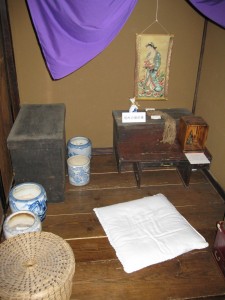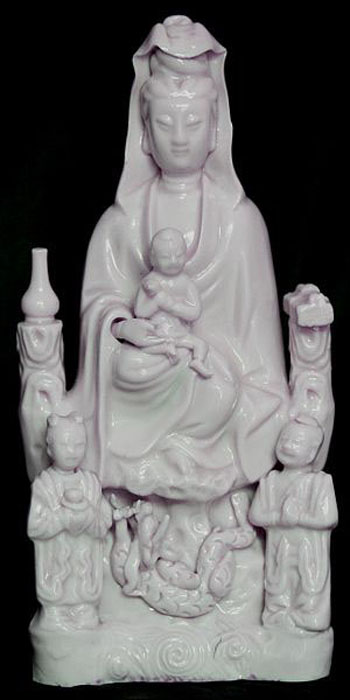Forgive me for a personal post here, but such is the state of printed matter these days that it’s rather rare to be able to boast of a book review, let alone a positive one. However, today’s Japan Times carries a pleasing piece about my work on Hidden Christians which I’m reproducing below. Though it may seem completely off-topic to this blog, there is in fact some relevance to Shinto as I tried to show in previous posts on the Hidden Christians. For those interested, please take a look at Part One and Part Two.
***************************************************************************************************
Sunday, Aug. 12, 2012 (Japan Times)
For the sake of survival: concealing the cross
By STEPHEN MANSFIELD
In Search of Japan’s Hidden Christians: A Story of Suppression, Secrecy and Survival, by John Dougill. Tuttle Publishing, 2012, 272 pp., $22.95 (hardcover)

Hidden Christian altar (in Ikitsuki Island Museum)
When you travel with a mission, a theme in mind, encounters unfold, stories are forthcoming, history uncoils. John Dougill begins his own journey into the history of Japan’s hidden Christians in Tanegashima, where the Portuguese, bearing matchlocks and bibles, first landed.
Perhaps memories of the failure of the Crusades continued to rankle in the corridors of the Vatican or Escorial. In the age of oceanic exploration, the Catholic Church was reinvigorated by the prospect of making converts in the East.
Unlike colonized regions of Asia where Catholicism thrived, the imported religion in Japan conflicted with loyalty to the shogun. There was also, as the writer explains, the problem of ancestor worship. The notion that non-Christian members of the family might be dispatched into a fiery damnation made many Japanese as uncomfortable as the concept of confession, in a society where people were taught to keep their private thoughts and emotions in check. Suicide, a virtue according to samurai culture, was a sin in the Catholic one.
Japan had grounds to be concerned. With the arrogance that characterized papal decrees, the Treaty of Tordesillas in 1494 saw Spain and Portugal dividing the known world into two spheres, with the former claiming possession of everything to the west, the latter the east. The unity of the cross and the sword was real. Missionaries formed a beachhead, softening the ground; soldiers arrived later to harden it.
Chapter One of Dougill’s book, focusing on Kagoshima, is aptly named Genesis, for it was here that the foreign faith made its first incursion in the form of the Jesuit zealot Francisco Xavier who, as the writer puts it, led a “religious crack force in the service of the pope.” Appropriately, each section of the book has a biblical title, so we have chapters with names like Commandments, Persecution, Revelation, and Last Rites, lending the work an almost scriptural weight.
The author describes how Christianity was linked to uprising, the components of doctrine often being less important than revolt against oppression. It is doubtful, in fact, whether many of the illiterate peasants who followed Christian leaders into battle, grasped the principals of the faith itself. The more powerful and better informed may have had their own agendas, the Japanese being, then as now, nothing if not pragmatic. Many of the conversions of daimyo were trade motivated. Dougill quotes the old truism, “whereas the missionaries used trade to get the Japanese to heaven, the Japanese used heaven as a way to get trade.”
Dougill provides some interesting, little known facts of history. During Hideyoshi’s invasion of Korea, for example, we learn of tension between the two Japanese armies, one led by a devotee of Nichiren and bearing pendants with Glory to the Lotus Sutra on them; the other, with a Christian general at its head, their soldiers carrying crosses.
The instruments of persecution appeared as early as the 1560s, however, when an unnamed woman was beheaded for the crime of praying in front of a cross. Even given the times, the depth of cruelty is difficult to grasp. Before the 26 Martyrs of Nagasaki were crucified — a 12-year-old boy was among them — their right ears were cut off, and the prisoners displayed in carts. The Japanese authorities executed over 4,000 people in a mere 30-year period, more than the Portuguese Inquisition managed in over 250 years. Thousands more were tortured, with methods ranging from snake and excreta pits to amputations, water torture, branding, upside down suspension, and suffocation among them. It is hardly surprising that, with Christianity banned, thousands of converts would go underground, creating a syncretic form of the faith that, even today, is not fully recognized by the Catholic Church in Japan.
A nonfiction work about devotion, the book is also a lively travelogue. And Dougill is a tireless journeyman and sleuth, going to wherever there is a story or lead. He tracks down descendants of hidden Christians on the island clusters of Amakusa, Goto and Ikitsuki, meets with curators, historians in Shimabara and Nagasaki, engages fisher folk in conversations about history.
Dougill has written an important book, one that bears accurate and empathetic testimony to a period that many would rather conceal behind the bloodstained drapes of history.


Leave a Reply